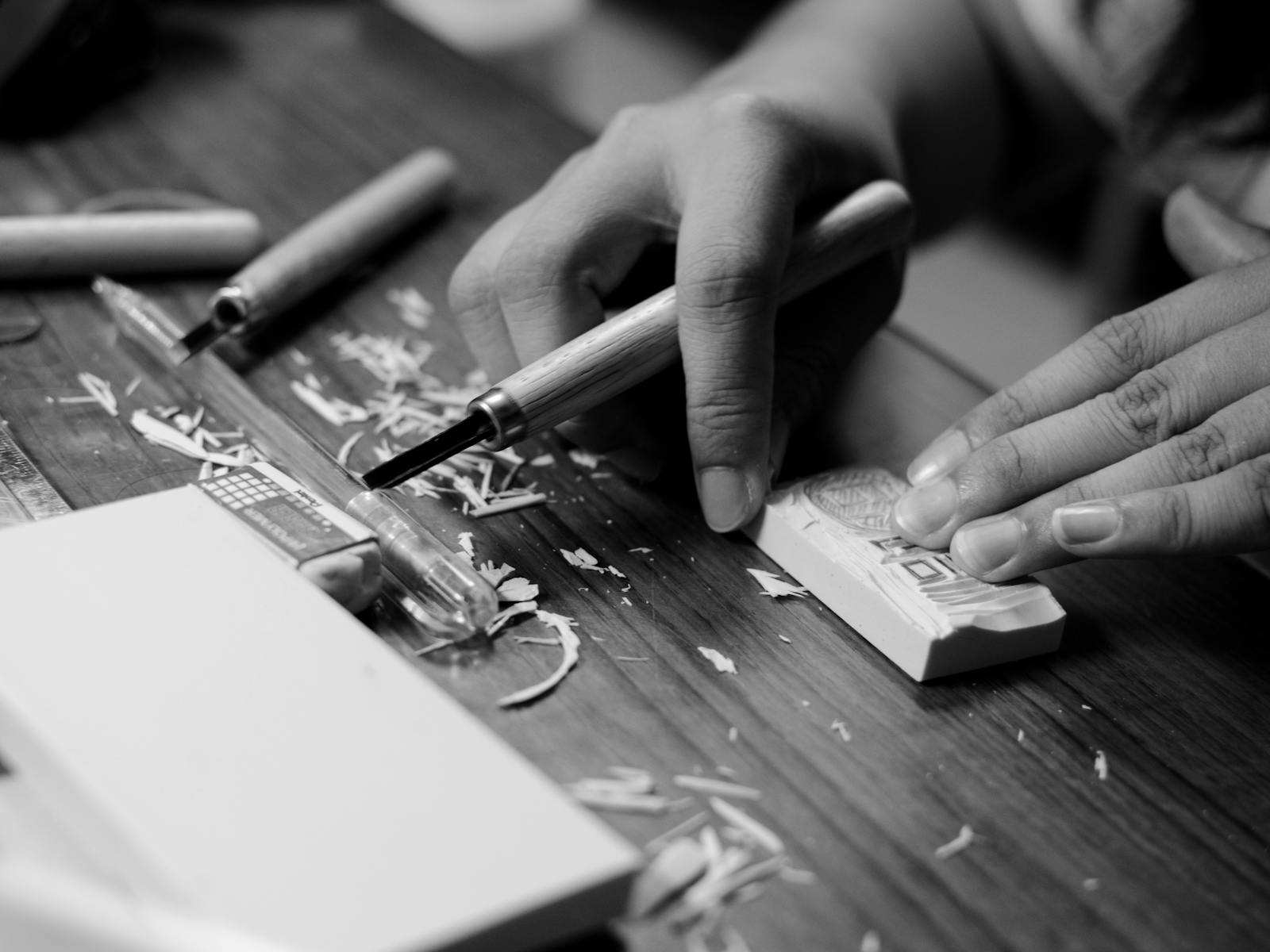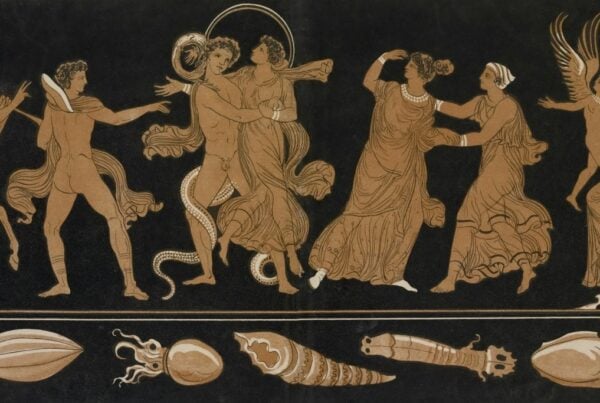Woodblock printing is an ancient art form that has stood the test of time. This technique originated in China and later spread across East Asia and the rest of the world.
It involves carving an image or design into a block of wood, then using that block to print on paper or fabric.
Woodblock printing dates back to antiquity and was first used to print on textiles before being adapted for paper. The oldest known printed text with a date, the Diamond Sutra from 868 AD, was created using this method.
It’s amazing to think that a technique developed so long ago is still in use today.
I’ve always been intrigued by the versatility of woodblock printing. It can be used to create everything from simple black and white designs to complex, multi-coloured works of art.
The process requires skill, patience, and creativity, making each print unique and special.
Table of Contents
Key Takeaways
- Woodblock printing has a rich history spanning thousands of years
- The technique can be used to create both simple and complex designs
- Modern artists continue to explore and innovate with woodblock printing
History of Woodblock Printing
Woodblock printing has a rich history spanning over a thousand years. It played a crucial role in spreading knowledge and art across cultures.
Origins in East Asia
Woodblock printing began in East Asia, with China being its birthplace. The technique emerged during the Tang Dynasty (618-907 AD). It started as a way to print on textiles and later expanded to paper.
The earliest dated printed text I know of is the Diamond Sutra from 868 AD. It’s a Buddhist text that shows how religion drove early printing.
Buddhist monks used woodblocks to meet the growing demand for religious texts and images. This method was much faster than hand-copying.
Development in China
In China, woodblock printing grew beyond religious use. It was used to print books on agriculture, medicine, and calendars.
The process involved carving text or images into a wooden block. Then, the printer applied ink and pressed paper onto the block to transfer the design.
Printing spread knowledge and helped preserve Chinese culture. It made books more available and affordable.
As the technique improved, printers created intricate designs and illustrations. This led to the production of beautiful art prints.
Spread Through Asia and Europe
From China, woodblock printing spread to other parts of Asia. Korea and Japan adopted the technique, each adding their own styles.
In Japan, it led to the creation of Ukiyo-e art during the Edo period. These colourful prints depicted everyday life and became very popular.
Europe learned of woodblock printing much later. It arrived in the 14th century and was used to create ‘block books’.
These books had both text and images carved on the same block. They were cheaper to produce than handwritten manuscripts.
Woodblock printing paved the way for movable type, which revolutionised printing in Europe.
Materials and Tools
Woodblock printing requires specific supplies and equipment. The main components are the woodblock itself, inks, carving tools, and printing apparatus. Each plays a crucial role in creating beautiful prints.
Woodblocks and their Selection
Choosing the right woodblock is essential for a successful print. Shina plywood is a popular choice due to its smooth surface and ease of carving. It’s less prone to splintering than other materials.
Hardwoods like cherry or maple offer durability but can be challenging to carve. On the other hand, soft woods like pine are easier to work with but may not hold fine details as well.
I always consider the size and thickness of the block based on my design. Larger blocks allow for more detailed work, while smaller ones are great for simple designs or repeat patterns.
When selecting a block, I check for knots or irregularities that might affect carving or printing. A smooth, even surface is ideal for achieving clean prints.
Inks and Pigments
The choice of ink greatly impacts the final print. I use water-based inks for their easy cleanup and quick drying time. They work well on paper but may not be suitable for all surfaces.
Oil-based inks, on the other hand, offer richer colours and work on a wider range of materials, including fabric.
For traditional Japanese woodblock printing (mokuhanga), I opt for water-based pigments mixed with rice paste. Sumi ink, a type of black ink made from pine soot, is excellent for monochrome prints.
I always test inks on scrap material before applying them to my final block. This helps me gauge how they’ll behave during printing and ensures the desired result.
Carving Tools
Proper carving tools are crucial for creating detailed woodblocks. I use a variety of gouges, chisels, and knives to achieve different effects.
- V-gouges: For fine lines and details
- U-gouges: For clearing larger areas
- Chisels: For straight cuts and edges
- Knives: For intricate work and outlining
I keep my tools sharp for clean, precise cuts. A wire brush is handy for cleaning debris from the carved areas.
It’s important to hold tools correctly and carve away from your body for safety. I always wear cut-resistant gloves to protect my hands.
Printing Apparatus
The right printing equipment ensures clean, even prints. I use a brayer or roller to apply ink evenly to the woodblock. Different sizes and materials of brayers suit various projects.
For hand printing, I rely on a baren – a flat, disc-shaped tool used to press the paper onto the inked block. It helps distribute pressure evenly without a press.
Carbon paper is useful for transferring designs onto the woodblock. I place it between my sketch and the wood surface, then trace the design.
For larger or more complex prints, a printing press can be helpful. It applies consistent pressure across the entire block, resulting in more uniform prints.
Woodblock Printing Techniques
Woodblock printing is a versatile art form with various methods. I’ll explore relief printing, Japanese mokuhanga, and textile printing techniques. Each approach offers unique qualities and creative possibilities.
Relief Printing Process
Relief printing starts with carving a design into a block of wood. I use sharp tools to remove areas that won’t print, leaving raised surfaces to hold ink. Here’s the basic process:
- Sketch the design on paper
- Transfer it to the wood block
- Carve away non-printing areas
- Roll ink onto the raised surfaces
- Press paper onto the inked block
I can use a printing press or hand-printing tools like a baren. The baren is a flat disc used to rub the back of the paper, transferring ink from block to paper.
For multicolour prints, I carve separate blocks for each colour. Proper registration is crucial to align colours correctly. Some artists use reduction printing, carving away more of the same block for each colour layer.
Japanese Mokuhanga
Japanese-style woodblock printing, or mokuhanga, uses water-based pigments instead of oil-based inks. I apply pigments with brushes rather than rollers. This technique offers subtle colour blending and transparent effects.
Key features of mokuhanga:
- Water-based pigments
- Brushes for ink application
- Thin washi paper
- Kento registration marks
- Hand-printing with a baren
I carve designs into cherry or shina plywood using special woodcarving tools. The wood grain often shows in the final print, adding texture. Mokuhanga allows for delicate gradients and colour overlays, creating nuanced images.
Woodblock Printing on Textiles
Woodblock printing on textiles has a rich history in many cultures. I use blocks to stamp repeating patterns onto fabric. This technique works well for creating decorative textiles like wallpaper, clothing, and furnishings.
For fabric printing, I use:
- Thicker, more durable wood blocks
- Fabric inks or dyes
- Padded printing surfaces
I apply ink to the block with a brayer or brush, then press it firmly onto the fabric. Proper ink consistency is crucial for clear prints.
Some artists use carved linoleum or rubber blocks for similar effects on textiles.
To ensure even coverage, I carefully plan the repeat pattern. Registration marks help align multiple colours or blocks. This method allows for intricate, colourful designs on various fabric types.
Cultural Significance and Influences
Japanese woodblock prints have shaped art and culture for centuries. They capture everyday life, influence global artists, and preserve traditional craftsmanship.
Ukiyo-e and the Floating World
Ukiyo-e prints, or “pictures of the floating world”, played a key role in Edo period society. These vivid images depicted the fleeting pleasures of urban life. The subjects range from kabuki actors to beautiful women and landscapes.
Ukiyo-e also had deeper meanings. Some prints explored Buddhist ideas about life’s transience, while others illustrated popular stories and legends.
The art form wasn’t just for the elite. Common people could afford these prints, making art accessible to all. This helped spread cultural ideas and fashion trends across Japan.
Influence on Western Art
When Japan opened to trade in the 1850s, ukiyo-e prints caused a stir in Europe. Their bold colours and unique style captivated artists like Van Gogh and Monet.
This fascination led to a movement called Japonisme. Western artists began to use flat colours, unusual angles, and asymmetrical designs inspired by ukiyo-e.
Katsushika Hokusai’s “The Great Wave off Kanagawa” became an icon. Its dynamic composition and striking use of blue pigment influenced countless artists worldwide.
Preservation of a Traditional Craft
Today, woodblock printing remains a valued art form. Skilled craftsmen keep the techniques alive, passing knowledge down through generations.
The process is complex, involving artists, carvers, and printers. Each step requires years of training to master.
Modern artists continue to use woodblock printing. They blend traditional methods with new ideas, keeping the art form fresh and relevant.
Museums and collectors prize historical prints. This helps preserve Japan’s cultural heritage for future generations to study and admire.
Modern Woodblock Printing and Its Evolution
Woodblock printing has evolved significantly in recent years. New technologies, innovative artists, and educational initiatives have transformed this traditional art form.
Technological Advancements
Modern woodblock printing uses advanced tools and materials. Artists now employ laser cutters to create intricate designs on woodblocks, allowing for more detailed and precise prints.
Computer-aided design software helps plan complex layouts before carving. Some printmakers use power tools like Dremels for faster, more efficient carving.
New ink formulations produce vibrant colours that are lightfast and archival-quality. Specialised presses allow for greater control over pressure and registration.
These innovations blend traditional techniques with modern capabilities, expanding creative possibilities for artists.
Contemporary Artists and Studios
Many artists and studios are breathing new life into woodblock printing. I’ve noticed a trend of combining traditional Japanese ukiyo-e techniques with contemporary subjects and styles.
Some notable contemporary woodblock artists include:
- Tugboat Printshop (USA)
- Laura Boswell (UK)
- Katsutoshi Yuasa (Japan)
These artists push the boundaries of the medium, creating large-scale prints, experimenting with unconventional materials, and addressing current social issues through their work.
Studios like Peacock Print Studio in Aberdeen offer facilities and expertise for both traditional and modern woodblock printing techniques.
Educational Aspects and Workshops
Woodblock printing is gaining popularity in art education. Many schools and community centres offer workshops to introduce people to this art form.
I’ve attended classes where participants learn:
- Wood selection and preparation
- Carving techniques
- Ink application
- Printing methods
Online tutorials and video courses have made learning woodblock printing more accessible. These resources cover everything from basic skills to advanced techniques.
Some art schools now offer dedicated printmaking programmes that include woodblock printing as a major component. This ensures the continuation and evolution of this historic art form.
Frequently Asked Questions
Woodblock printing has a rich history and diverse applications. Let’s explore some common questions about this traditional art form, its techniques, and cultural significance.
What is the history of woodblock printing?
Woodblock printing dates back to ancient civilisations. It began in China during the Han Dynasty around 200 CE. The technique spread to other parts of Asia and eventually reached Europe in the 14th century.
How is woodblock printing carried out?
To create a woodblock print, I carve an image onto a wooden block using special tools. Then I apply ink to the raised surfaces and press paper onto the inked block to create a print.
For what purposes was woodblock printing traditionally used?
Woodblock printing had many uses throughout history. It was used to make books, religious texts, and playing cards. Artists also used it to create beautiful prints and illustrations.
What are the essential tools needed for woodblock printing?
The main tools for woodblock printing include carving knives, gouges, and chisels. I also need wood blocks, ink, and paper. A baren or printing press helps transfer the image to paper.
Who is credited with the invention of woodblock printing?
No single person invented woodblock printing. It developed gradually in ancient China, and the earliest known printed text is the Diamond Sutra from 868 CE.
How does Japanese woodblock printing differ from other forms?
Japanese woodblock printing, or ukiyo-e, has unique features. It often uses water-based inks instead of oil-based ones. The prints typically depict landscapes, actors, and scenes from daily life.








